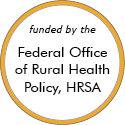Rural Mental Health – Models and Innovations
These stories feature model programs and successful rural projects that can serve as a source of ideas and provide lessons others have learned. Some of the projects or programs may no longer be active. Read about the criteria and evidence-base for programs included.
Other Project Examples
The Sapling Center
Updated/reviewed June 2025
- Need: To create a safe space for youth and young adults, ages 14 to 25, in rural eastern Kentucky.
- Intervention: The Sapling Center provides independent living skills education and offers a wide array of services as well as fun activities in a supportive environment.
- Results: The 5 Sapling Center locations serve 50-75 teens and young adults every day.
Together We Can Be Bully Free
Updated/reviewed June 2025
- Need: Union Parish, a rural county in Louisiana, continues to experience elevated rates of youth suicide, bullying, mental health challenges, and risk behaviors, as confirmed by a 2024 Community Health Needs Assessment (CHNA).
- Intervention: Union General Hospital, a Critical Access Hospital, started a program to educate students grade 4 through 12 on the negative effects of bullying, to foster positive social behavior, and to provide mental health support through school-based interventions.
- Results: Over 3,500 students have learned how to recognize, report, and respond to bullying. The program's integration with broader community health priorities has strengthened mental health, reduced suicide attempts, and improved awareness of youth risk behaviors.
Project ACTIVATE (Advancing Coordinated and Timely InterVentions, Awareness, Training, and Education)
Updated/reviewed May 2025
- Need: To improve students' access to behavioral health services in rural North Carolina.
- Intervention: North Carolina Project ACTIVATE provides three tiers of behavioral health supports in the school setting.
- Results: The six pilot sites (Cohorts 1 and 2) have created or revised 91 mental health policies, and 48,531 school-based and related employees have received training in different topics and protocols.
Regional Behavioral Health Network
Updated/reviewed April 2025
- Need: Multiple organizations in rural east central Illinois needed a more efficient, centralized system for referring patients experiencing a behavioral health crisis to appropriate treatment services.
- Intervention: The Regional Behavioral Health Network was established with a 24-hour toll-free crisis line, providing immediate access to trained crisis clinicians.
- Results: Improved access to high quality behavioral healthcare for patients in rural east central Illinois.
SCDMH Emergency Department and Community Telepsychiatry Programs
Updated/reviewed April 2025
- Need: To expand access to psychiatric services throughout South Carolina, with a focus on underserved and rural communities.
- Intervention: South Carolina Department of Mental Health (SCDMH) created the SCDMH Emergency Department and Community Telepsychiatry programs to expand telepsychiatry access for patients in emergency departments and in various settings across the state.
- Results: The program has improved access, affordability, and provided quality care for patients with mental illness living in rural and underserved areas of South Carolina.
Coast to Forest: Mental Health Promotion in Rural Oregon and Beyond
Updated/reviewed January 2025
- Need: To promote mental health and prevent substance use disorders in rural Oregon, Washington, Idaho, and Alaska.
- Intervention: Coast to Forest strengthens local capacity through training, technical assistance, education, and community partnerships.
- Results: In its five years of operation, the project has trained over 800 individuals across the Pacific Northwest in Mental Health First Aid, developed 100 county-level resource guides, organized a series of Community Conversations in five rural Oregon counties, and more.
Marshall University Rural Psychiatry Residency Program
Added December 2024
- Need: To train the next generation of psychiatrists in a rural context, while providing psychiatric care to an underserved region of West Virginia.
- Intervention: A new rural psychiatry residency program at Marshall University, in which residents split their time between the rural town of Point Pleasant and the larger city of Huntington.
- Results: The program welcomed its first class of residents in July 2024.
Butte Child Evaluation Center

Updated/reviewed August 2024
- Need: Before 2000, Butte and southwest Montana saw around 1,300 cases of child abuse a year, with only a 20% conviction rate for perpetrators of sexual abuse.
- Intervention: Multiple agencies in the community came together to address the issue of child abuse by forming the Butte Child Evaluation Center (CEC), a Children's Advocacy Center.
- Results: During a 3-year grant cycle, over 200 interviews and exams were performed on victims of sexual abuse and the Butte CEC became the first program in Montana to be accredited by the National Children's Alliance.
The Rural Outreach Center
Updated/reviewed July 2024
- Need: To expand services for individuals and families living in poverty in rural Western New York.
- Intervention: The Rural Outreach Center (ROC) offers care coordination, therapy, budgeting assistance, and multiple other services and opportunities to help address immediate needs as well as empower individuals to work toward long-term freedom from generational poverty.
- Results: The Rural Outreach Center serves approximately 250 adults and children each year through counseling, care coordination, and empowerment opportunities. The ROC reports that many participants have achieved and sustained goals related to housing, savings, employment, and other social determinants of health – which are also measures of poverty.
Florissa


Updated/reviewed June 2024
- Need: To address the developmental, behavioral, and social/emotional needs of rural children ages 0-22 in northwest Illinois.
- Intervention: Local partners teamed up to create a centralized service facility for children and families facing developmental, behavioral, and social/emotional issues. Florissa provides evaluations, diagnosis, and treatment to local children using a multidisciplinary, evidence-based approach.
- Results: In 2023, Florissa provided a direct clinical service to over 337 children, in addition to many trainings and supportive programs. It also is co-located with the KSB Hospital pediatric department, a certified pediatric patient-centered medical home (PCMH).
Last Reviewed: 6/7/2024

